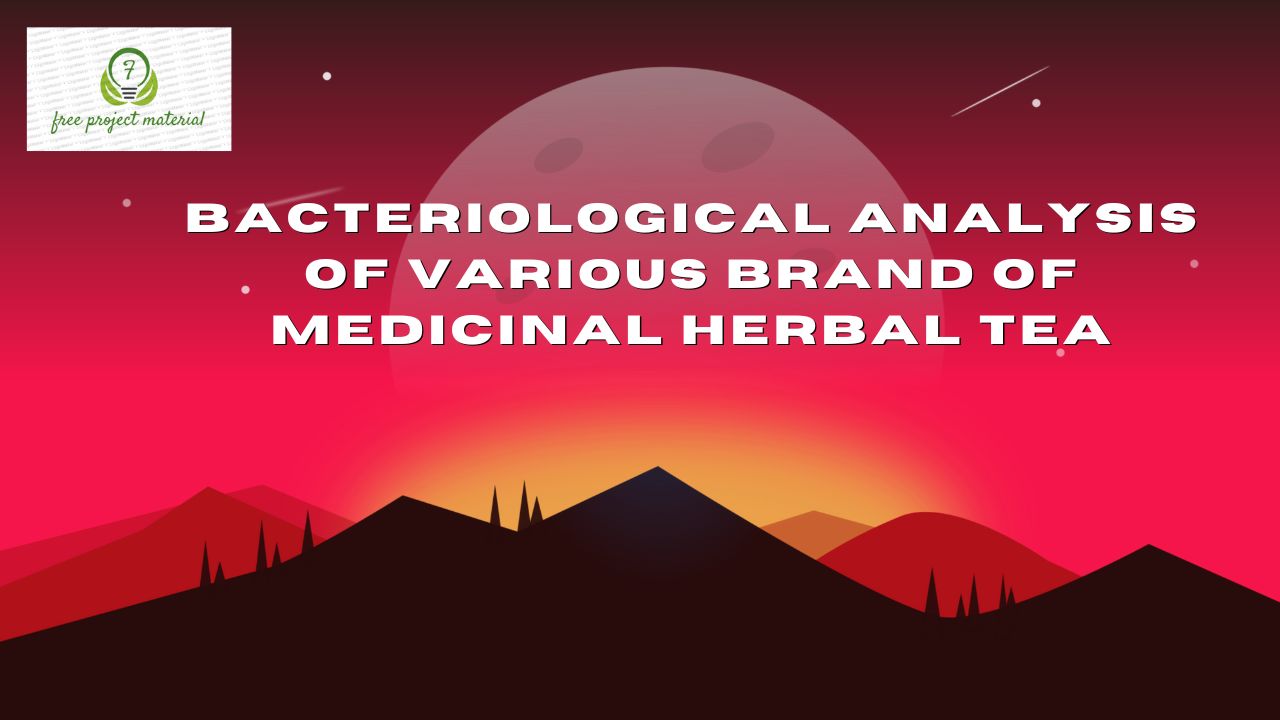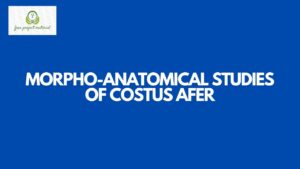ABSTRACT
The aim of this study was to assess the bacteriological contamination of various herbal tea. Five samples were collected for the study and standard aseptical methods were employed in carrying out the analysis. The result of the study revealed that sample C had the highest bacterial count of 1.06×105 cfu/ml while sample D had the least bacterial count of 4.7×104 cfu/ml. The bacterial isolates obtained in the study were Bacillus sp, Staphylococcus sp, Salmonella sp, Escherichia sp, Escherichia sp and Klebsiella sp with Staphylococcus sp having the highest percentage of occurrence (22.5%) while the least was Escherichia sp with 16.6%. High bacteria contamination could constitute a health hazard if the organisms present are pathogenic or capable of producing toxin under favourable conditions. Thus good manufacturing practices (GMPs) and appropriate hygiene should be adhered to for high quality herbal teas.
TABLE OF CONTENTS
Title page – – – – – – – i
Certification – – – – – – – – ii
Dedication – – – – – – – – iii
Acknowledgements – – – – – – iv-v
Abstract – – – – – – – – vi
Table of Contents – – – – – – – vii-ix
CHAPTER ONE: INTRODUCTION
1.1 Background of the Study – – – – – – 1-4
1.2 Aim and Objective of the study – – – – – 4
1.3 Scope and Limitation of the study – – – – 4
CHAPTER TWO: LITERATURE REVIEW
2.1 Overview of Herbal tea – – – – – – 5-8
2.2 Production and Consumption of Herbal tea – – – 8-9
2.3 Nutritive value of fresh tea leaves and shoot – – – 9-11
2.4 Different types of tea based on the method of production – 11-18
2.5 Utilization of different plants in tea preparation – – 18-22
2.6 Advantages of medical herbal tea – – – – 22-24
2.7 Disadvantages of herbal tea – – – – – 25-27
2.8 Side effects of source medical herbal tea – – – 27-28
2.9 Microbial contaminants of medicinal herbal tea – – 28-30
CHAPTER THREE: MATERIALS AND METHOD
3.1 Materials – – – – – – – – 31
3.2 Methods – – – – – – – – 31
3.2.1 Sample collection – – – – – – – 31
3.2.2 Serial Dilution – – – – – – – 32
3.2.3 Sterilization of media and glasswares – – – – 32
3.3 Microbiological Analysis – – – – – – 33
3.3.1 Cultivation of microorganism – – – – – 33
3.3.2 Enumeration of Bacterial isolates – – – – 33
3.3.3 Purification of Bacterial isolated – – – – 34
3.4.4 Characterization and Identification of Bacterial isolates – 34-35
CHAPTER FOUR: RESULTS AND DISCUSSION
4.1 Results – – – – – – – – 36-39
4.2 Discussion – – – – – – – – 40-44
CHAPTER FIVE: CONCLUSION AND RECOMMENDATIONS
5.1 Conclusion – – – – – – – – 45
5.2 Recommendations – – – – – – – 45
References
CHAPTER ONE
INTRODUCTION
1.1 Background of the Study
An herb in phytomedicine denote a plant part that is employed in medicine-making to aid the healing process in time of illness or disease. Herbal teas consist of exclusively of one or more plant such as leaves, flower, bark or seeds prepared by means of decoction or infusion. Herbal teas are wonderful, low calorie and relaxing drinks. They have beautiful fragrance and are very appealing. When brewed for 5-10 minutes are immediately taken. Herbal tea are usually supplied in wholesale quantity or retail sachets (Lailand Roy, 2004). Many herbal tea are found around the used as herbal tea and as a medicinal plant by traditional African people (Robert, 1990). Green tea is herbal tea of great health benefit that it is called the wonder herb. This product has high concentration of polyphenols which are known to exert a wide range of beneficial biochemical and physiological properties (Hirasatwa et al., 2002; Mogothane et al., 2007).
Herbal tea have many health benefits and they taste great too. The widespread popularity of herbal teas such as green tea, rooibos and chamomile is due to their perceived therapeutic effects against some chronic disease (Joubert et al., 2008). When administered, chamomile has been found to sooth the stomach, relieves indigestion, fight insomnia, calmly the body and mind thus relieving stress. Decoctions of spearmint (Mentha spicata), marjoram (Origanum marjorana), thyme (Thymus vulgaris) and papaya. Mint tea are primarily consumed to treat digestive ailments, to reduce fever and for their anti-inflammatory, anti-oxidant and antimicrobial properties (Abe et al., 2004; Dorman et al., 2004). Despite the significant role of herbal teas in improving nutrition and health, there have been reports of microbial contamination and adverse effects resulting from their consumption. These include neurological, cardiovascular and haematological hazard (Palmer et al., 2003). Toxin-producing microbial contaminants are often the cause of these adverse effects. Therefore, it is important to identify the microbial contaminants of herbal tea products as indicators of safety and quality (Schweiggert et al., 2005).
A few reports demonstrating microbial contamination of medicinal herbs from various parts of the world exist in the literature. (Rizzo et al., 2004). Indicated that medicinal plants in Argentina harbored toxigenic fungi such as A. flavus, A. parasiticus and several members of the genus Fusarium (Efuntoye, 1999) showed that dried medicinal plants from Nigeria herb markets contained A. flavus, A. parasiticus and A. ochraceus. He added that the above fungal isolates were capable of producing mycotoxins when grown on semi-synthesis media (Martin et al., 2001), after evaluating several medicinal herbs obtained from Portugese markets, reported that the commodities were infested with variety of moulds such as Aspergillus and Fusarium spp (Halt, 1998) isolated a wide spectrum of fungi (including Aspergillus, Penicillium, Alternaria, cladosporium, Rhizopus and Mucor species) from Croatian herbal teas and medicinal plants (Czech et al., 2001) reported bacterial and fungal contamination of medicinal herbs in Australia, while (Shorska et al., 2005) showed that the air in chamomile and peppermint processing farms in Poland contained high levels of Pantoea agglomerans and other gram negative bacteria. Such report indicate the existence of a ubiquitous problem. In Akwa Ibom State, Nigeria, there are many retail outlets for a host of herbal teas with promising cure, howbeit without thinking of the microbiological and fungal contamination of herbal teas in the Nigerian market with special reference to Akwa Ibom State.
1.2 Aim and Objectives of the Study
The aim of this study is to analyze the microbiological load of herbal.
The objectives of this study are;
- To examine the bacterial load of herbal
- To find out the fungal load of herbal
- To compare the result of this study with previous work.
- To make useful recommendation base on the result of this study.
1.3 Scope and Limitation of the Study
The scope of this study focus on the fungal and bacteriological analysis of herbal tea sold within Ikot Ekpene metropolis. This is due to tome and financial constraint.


